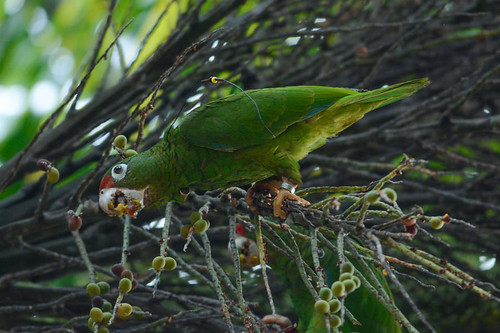 Puerto Rican parrot near the Rio Abajo Nature Preserve, in Puerto Rico. The parrot who is wearing an electronic monitoring device and a tag is one of a pair of birds that had been reintroduced into the wild by scientists. image by: AP Photo/DRNA, Tanya MartínezSAN JUAN, Puerto Rico (AP) — Two endangered Puerto Rican parrots were born in the wild in a natural nest found outside a national forest in the U.S. territory for the first time in 144 years, officials said Tuesday.
Puerto Rican parrot near the Rio Abajo Nature Preserve, in Puerto Rico. The parrot who is wearing an electronic monitoring device and a tag is one of a pair of birds that had been reintroduced into the wild by scientists. image by: AP Photo/DRNA, Tanya MartínezSAN JUAN, Puerto Rico (AP) — Two endangered Puerto Rican parrots were born in the wild in a natural nest found outside a national forest in the U.S. territory for the first time in 144 years, officials said Tuesday.
Scientists discovered the nest in May near the Rio Abajo Nature Preserve in western Puerto Rico and monitored it with cameras until they saw the parrots take flight in late July, according to Natural Resources Secretary Carmen Guerrero.
"The historical importance of this makes your hairs stand up," she said in a phone interview. "They're one of the top 10 most endangered birds in the world."
The two parrots were born to birds that had been reintroduced into the wild by scientists in the Rio Abajo Nature Preserve, one of two breeding centers in the island located in western Puerto Rico.
 A breeding pair of endangered Puerto Rican parrots near the Rio Abajo Nature Preserve, in Puerto Rico. Image by: AP Photo/DRNA, Tanya MartínezParrots had previously been born in natural nests in 1973 and 1993 in El Yunque, the only tropical rain forest in the U.S. National Forest system that also serves as a breeding center in northeast Puerto Rico. Scientists also found eggs in a natural nest last year, but the birds didn't hatch.
A breeding pair of endangered Puerto Rican parrots near the Rio Abajo Nature Preserve, in Puerto Rico. Image by: AP Photo/DRNA, Tanya MartínezParrots had previously been born in natural nests in 1973 and 1993 in El Yunque, the only tropical rain forest in the U.S. National Forest system that also serves as a breeding center in northeast Puerto Rico. Scientists also found eggs in a natural nest last year, but the birds didn't hatch.
Guerrero said the highest number of parrots born in the wild in western Puerto Rico reached an all-time high this year at 16, with two of those being born in the natural nest and the remainder in artificial nests placed in the wild. In addition, there were 46 parrots born in captivity this year at the Rio Abajo Nature Preserve compared with 51 last year.
"These have been the highest two reproductive years in history," she said.
The birds are Puerto Rico's only remaining native parrot and one of roughly 30 species of Amazon parrots found in the Americas. They have red foreheads, turquoise feathers under their wings and grow to nearly a foot in length. They are known for their secrecy and usually mate for life, reproducing once a year.
Miguel Garcia Bermudez, director of the island's Fisheries and Wildlife bureau, said in a phone interview that the two parrots are not being electronically monitored because scientists decided not to intervene after a lengthy debate given the potentially fragile situation. He said once the parrots take flight from a nest, they don't return.
"Usually they abandon the nest at the encouragement of their parents. That doesn't change with birds either," he said with a laugh.
 Two endangered Puerto Rican parrots where born from the introduced breeding pair and are the first ones born in the wild outside a national forest, in a natural nest, for the first time in 144 years. Image by: AP Photo/DRNA, Tanya MartínezMore than 1 million Puerto Rican parrots were believed to be in existence in the 1800s, but the counted population plummeted to just 13 in 1975 after decades of forest clearing to plant citrus, coffee and sugar cane. Their numbers have since rebounded, with 409 parrots in captivity and an estimated 75 to 142 living in the wild, Guerrero said.
Two endangered Puerto Rican parrots where born from the introduced breeding pair and are the first ones born in the wild outside a national forest, in a natural nest, for the first time in 144 years. Image by: AP Photo/DRNA, Tanya MartínezMore than 1 million Puerto Rican parrots were believed to be in existence in the 1800s, but the counted population plummeted to just 13 in 1975 after decades of forest clearing to plant citrus, coffee and sugar cane. Their numbers have since rebounded, with 409 parrots in captivity and an estimated 75 to 142 living in the wild, Guerrero said.
Puerto Rican authorities are working alongside U.S. officials this year to build a third breeding center in the western town of Maricao, with plans to release 20 to 25 parrots by December 2015.
Cynthia Doher, a director with the U.S. Fish and Wildlife Service, said in a statement that the aim is to have a self-sufficient parrot population that does not require human intervention.
"This event brings us closer to our objective," she said of the two parrots being born in a natural nest in the wild. "This is a very significant achievement."